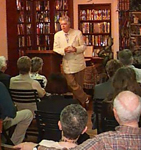|
|
CLASSIC 1986 HACKER THRILLER THE TRAPDOOR NOW RE-ISSUED AS AN E-BOOK The Trapdoor Novel is a Trip Back in Time to the Early 1980s, When Personal Computers First Emerged – and So Did Hackers What Motivates Hackers? A “Trapdoor” is a Computer Technique that Hackers Use for Theft September 9, 2020, Hilo, Hawaii – Hal Glatzer’s The Trapdoor, a classic paperback thriller from the 1980s about computer hackers and cyber-crime, has been re-issued as an e-book. Published in mobi (Kindle) format and epub format for tablets, smartphones, and computers, the novel is available today from Amazon’s Kindle Store, at: https://www.amazon.com/s?k="The+Trapdoor"+glatzer&i=digital-text&ref=nb_sb_noss and Glatzer’s website at: www.halglatzer.com. The Trapdoor was one of the first published novels to be set in the underground world of cyber theft and online pornography. In the book, a hacker gets into trouble with organized crime and has to hack his way out. The “trapdoor” title refers to a sinister technique for theft; but it also alludes to the risk of falling into one’s own trap. What Motivates Hackers? A forerunner to today’s notorious hackers, such as “Anonymous,” the protagonist of The Trapdoor is Joe (alias “The Lightning”), a techie nerd who lives quietly in a small apartment, surrounded by computers. He secretly steals money online, not just for the money, but also to flirt with danger -- an addiction for many hackers. “The Lightning” is drawn into a wider digital underworld of theft and porn until he’s not safe anymore. Suddenly he has enemies that want to kill him. “Machine of the Year” Progress in computer technology was front-page news. In 1983, TIME magazine – for the first time ever – didn’t name a “Man of the Year.” Instead, the editors named the personal computer “Machine of the Year.” Entrepreneurs, like Bill Gates and Steve Jobs, were just getting noticed; and magazines were launched to help people use those new “machines.” Noisy modems slowly dialed computers over telephone lines and data storage was limited to mere kilobytes on easily-damaged floppy disks. But technologies were constantly surging forward, and illegal computing activities surged right along with them. Readers of The Trapdoor will get a glimpse of that early time, when anything seemed possible, and the shadowy side of high-technology was just coming into view. And readers of a certain age, who were intrigued by computers in the ’80s, will enjoy The Trapdoor as a trip back in time. Hal Glatzer wrote The Trapdoor while he was an editor and writer for the earliest computer magazines. He also wrote non-fiction books about word processing, satellites, and telecommunications. Interviewing technology entrepreneurs and insiders in the early ‘80s, inspired Glatzer to write this high-tech thriller. “At that time,” says author Hal Glatzer, “email, cellphones, and the internet were years away in the future. What was high-tech in 1980 looks primitive now, but it was the state-of-the-art. And people who mastered it could do some remarkable things with it, both legal and illegal. Technology has evolved since those days. But as long as loners find their inner strength to overcome bullies, this period-piece will remain an inspiration to all.” Availability Originally published as a paperback, The Trapdoor has just been re-issued as an e-book in both the mobi format (for Kindle readers) and the epub format (for computers, tablets, smartphones, and other devices). It is available immediately for $4.95 from Amazon’s Kindle Store, at: https://www.amazon.com/s?k="The+Trapdoor"+glatzer&i=digital-text&ref=nb_sb_noss and Glatzer’s website: www.halglatzer.com . For more about Hal Glatzer and his other works of fiction, please visit www.halglatzer.com or email info@halglatzer.com.
Author, Hal Glatzer About the Author
Hal Glatzer was there, then. He began his writing career as a newspaper reporter in 1970, and by the end of the decade, he was doing television news with portable videotape equipment. That technology intrigued him, as did another new invention: the computer word processor. So he decided to make the fast-moving digital world of computers and telecommunications his journalistic beat. In 1980, he bought his first computer: a Zenith Z-89. Using the eight-bit Zilog Z80 microprocessor and the CP/M operating system, the computer held 48 KB of internal memory (RAM), and used removable 5¼ inch floppy disks that held 100 KB. That may not seem like much computing power today, but it immediately boosted Glatzer’s productivity as a professional writer, and he turned that expertise into his first non-fiction book: Introduction to Word Processing (Sybex, 1981). He subsequently wrote two books on what was then the state-of-the-art in global telecommunications: The Birds of Babel: Satellites For a Human World (Sams, 1983); and Who Owns the Rainbow? Conserving the Radio Spectrum (Sams, 1984). Glatzer was one of the founders of the Computer Press Association, a virtual press club for fellow writers and editors in the field. He served as its vice president, and for six years chaired the committee that created and presented the annual Computer Press Awards for excellence in high-tech journalism. Glatzer has subsequently had more mystery novels published; but his first was The Trapdoor. “Considering how far information technology has progressed since the early ‘80s,” he says, “I want to give the computer users of today a good idea of what life was like when the computer revolution began, and give people like me, who were there, then, a trip into the past. And the best way to bring that vintage paperback to today’s tech-savvy readers is to turn it into an e-book.”
Press Contact For Review
Copies of the Trapdoor and Interviews:
|
|



